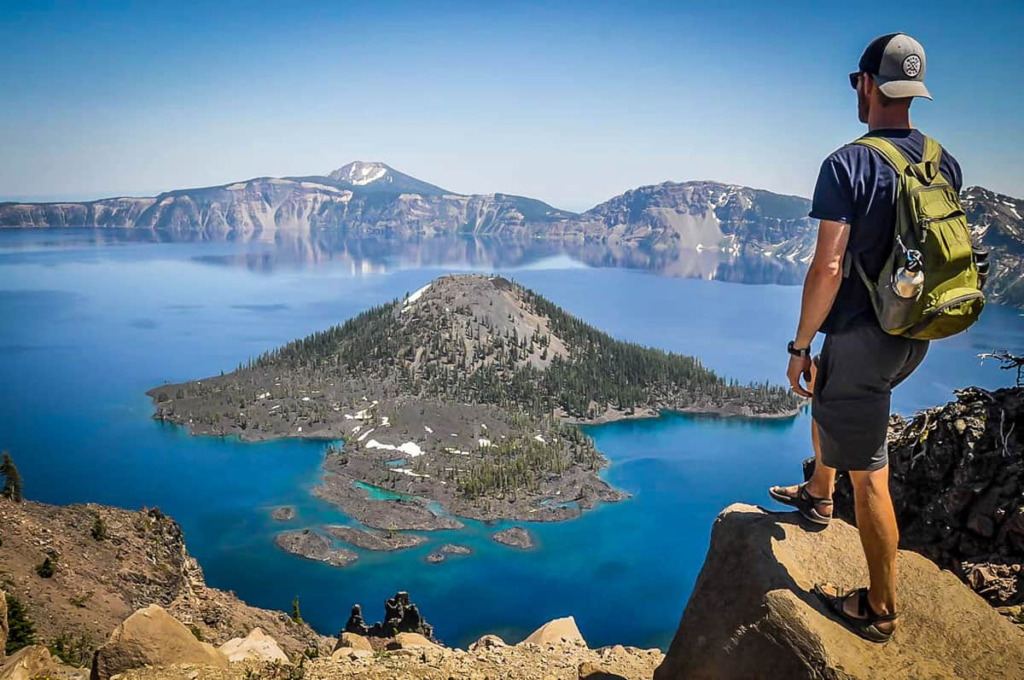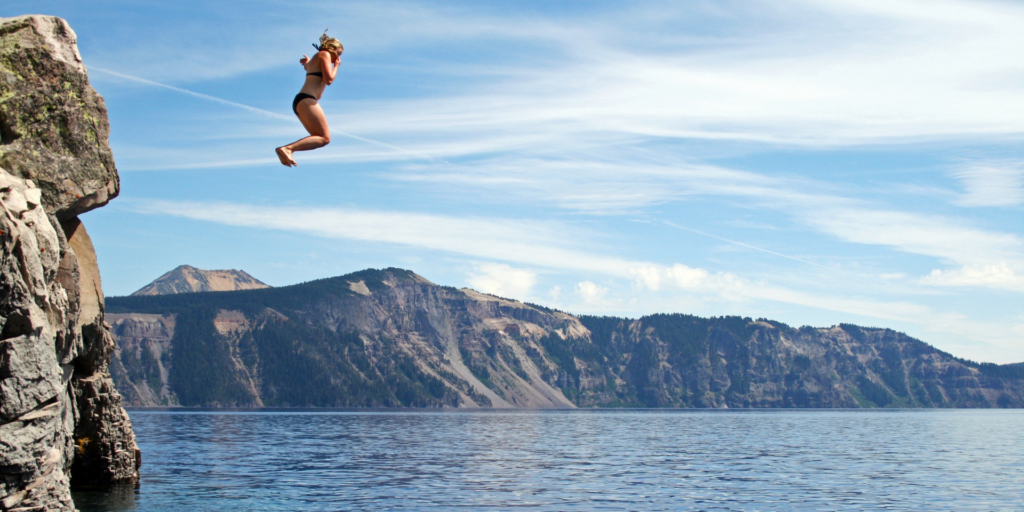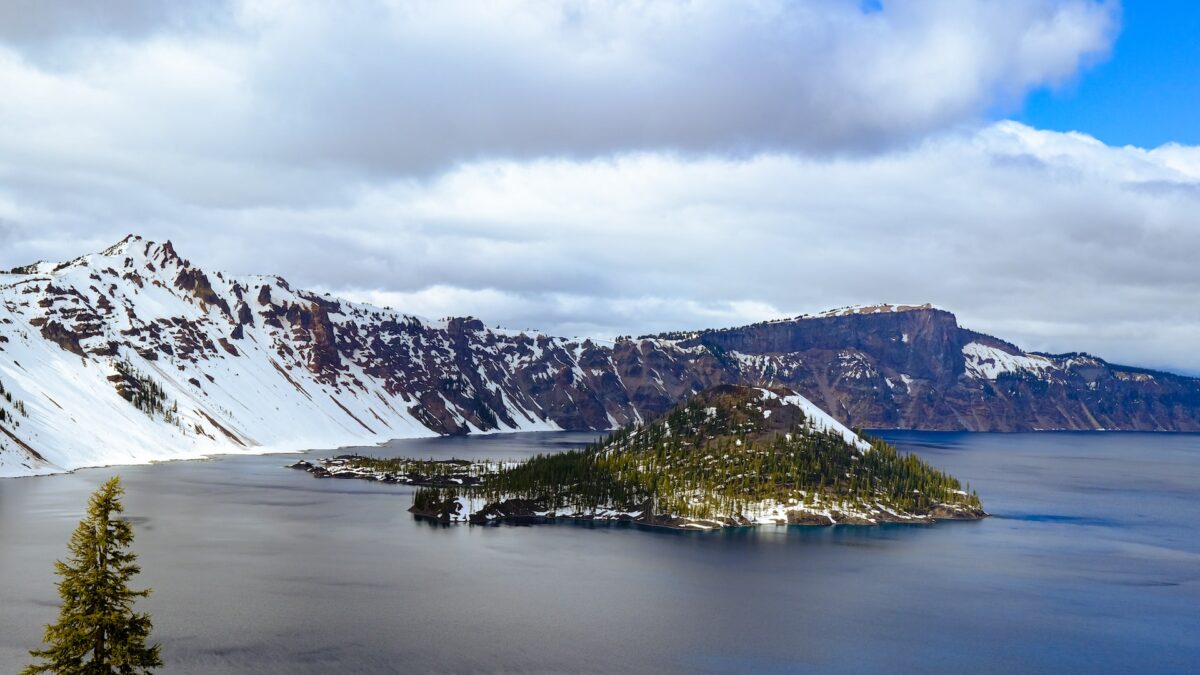The ancient mountain whose remains now form Crater Lake was known to the the Klamath, Modoc and Yahooskin Band of the Snake as Giiwas, or “sacred place.” It earned that name after the region`s Indigenous people witnessed a catastrophic volcanic explosion around 7700 years ago, an even that knit itself into their oral histories in such detail that Klamath mythology predicted geological discoveries that weren’t made until millennia later.
It may be hard to picture now, but Mount Mazama was a roughly 12,000ft volcanic peak that was heavily glaciered and inactive for many thousands of years until it came back to life. When the top of the mountain blew, it scattered ash for hundreds of miles as flows of superheated pumice solidified into massive banks. These eruptions emptied the magma chambers at the heart of the volcano, and the summit cone collapsed to form the caldera. Sparse forests can still be seen growing in pumice and ash in the Pumice Desert, just north of Crater Lake along North Entrance Rd. Further afield, outside the park, beloved attractions like Umpqua Hot Springs hint at the region’s ongoing geologic activity. Over time, snowfall and rain have contributed to the lake’s water. The purity of the springs and the great depth of the lake (at 1,943 feet, it’s the deepest lake in the United States) combine to give it its famous hue. The gorgeous blue waters of Crater Lake reflect the surrounding peaks like a giant dark blue mirror, making for spectacular photos and breathtaking panoramas.
Crater Lake National Park Highlights

The park’s popular south entrance is open seven days a week and provides access to the park’s headquarters at Limu and Mazama Villages and the Steele Visitor Centre. In winter, you can only climb to the edge of the lake and go down the same path. Other roads are not plowed. The north entrance is open only from early June to late October depending on snow conditions.
The Rim Drive
Whatever else you do, most visitors drive the 33-mile Loop Rim Drive. This drive is open from approximately June to mid-October and offers over 30 viewpoints along the rim of Crater Lake. Seven miles of back roads lead to pinnacles, pumice and volcanic ash layers carved by erosion into he 100-foot towers (“hoodoos”). A paved sidewalk on the east leads to breathtaking views from the Cloudcap Overlook about 2000 feet above the lake. This trip takes about an hour if you don’t stop off (but you have to stop).
Wizard Island

Whether just viewing Wizard Island from the rim of Crater Lake or visiting it by boat, it is undoubtedly one of the best features of this national park. The island is actually the tip of a cinder cone, about 755 feet above the surface of the lake. On the island you can hang out and swim, hike to the top of the cone or circle the rim (4km round trip). The Fumarol Trail (1.4 miles round trip) circles the coast along cold lava formations. To take the boat shuttle here, you must book in advance. This is only available during summer.
Tours
One of his most popular activities on Crater Lake is the ranger-led informative 2-hour Crater Lake Trolley Tour. The old-fashioned wood-paneled vehicle makes 5-7 stops, saving you the hassle of driving and parking, and receiving a highly insightful narration along the way.
A 2-hour boat tour is also available. It requires a fairly strenuous 30-40 minute hike down the crater to the dock (and then back). A 2-hour tour ($44 per person) includes a loop around the lake and access to Wizard Island for swimming and hiking ($55 per person). You can also take the shuttle to Wizard Island ($28 round trip). Make a reservation as it is popular.
Hiking and Snowshoeing

Crater Lake has more than 90 miles of hiking his trails, but some of the higher trails he hasn’t been completely cleared of snow until late July. The trails near Crater Lake Lodge and Mazama Village are the busiest, but with a little determination and a sweat you can get past the crowds and find spectacular trails and breathtaking views. Wildflowers bloom during the hiking season and later at higher elevations.
In winter, only the southern approach road to Rim Village is cleared of snow to allow access to some cross-country ski trails. Bring your skis as there are no rentals in the park. Only experienced skiers should attempt the dangerous and avalanche-prone loops around Crater Lake. This takes him two to three days and requires a backcountry permit from the Parks Authority. In winter, snowshoes are provided for free ranger-led snowshoe hikes. Please make a reservation by phone in advance.
Mt Scott

This strenuous 5-mile loop hike offers stunning lake views from the top of Crate Lake National Park’s highest point, Mount Scott at 8929 feet. It starts easily through meadows and climbs steeper (and breathless) as you get higher. Due to the high elevation, snow can be expected at the top of the trail year-round. It is said that this is the only place in the park where you can capture the entire lake with a single camera. This is also a great place to spot birds such as grouse, clarks nutcrackers and gray jays.
Garfield Tips
From the eastern end of the Rim Village parking lot, this short but steep 3.4-mile trail ascends Garfield Peak at 8,054 feet and offers sweeping views of the lake, Klamath Basin, and the southern Cascade Range. In July, the slopes are covered with wildflowers. This is one of his most popular hikes on Crater Lake, but it’s worth going despite the crowds. Snow can be expected throughout the season at higher elevations. Be prepared for shortness of breath from altitude if you are not acclimatized.
Watchman Lookout Tower

For a steep but short 1.4-mile hike, hike to Watchman, his old 1932-built lookout on the other side of the lake. From here you have one of the best views in the park, and arguably the best of Wizard Island. Wear good shoes to cross the boulder fields. Colorful wildflowers bloom from late August through October, and snow falls year-round. It can get windy here, so dress in layers.
Castle Crest Wildflower Garden Trail
For flower lovers, there’s a 1-mile nature trail near the Steele Visitor Center that winds through the Castle Crest Wildflower Gardens. Created in 1929, this trail was one of the first interpretive wildflower trails created within a national park. The trail winds through forested meadows and is dotted with wet meadows with stepping stones and streams. Surprisingly, there are very few people here, so it’s a great place to find some peace and quiet. Expect mosquitoes. Most flowers bloom early, around June.
Cleetwood Cove Trail

A very popular steep two-mile trail at the northern end of the crater provides the only water access in the bay. The bottom is rocky here, so bring a bathing suit (which will be with quite a few people) and waterproof shoes for a dip in the lake. Geology geeks will also love the chance to see the volcanic rocks that make up the caldera. Boat tours are available from here, but should be booked in advance. Street parking if full (sometimes full).
Pinnacles Overlook Trail

This short 1.2-mile trail of his is actually outside the park and offers another glimpse of geology. Follow Pinnacles Rd (by East Rim Dr) and continue down Pinnacles Rd (approximately 6 more miles) until you reach Pinnacles Overlook. Overlooking the colorful spire is about 100 feet high. The towers are fumaroles, where volcanic gases rise from hot ash deposits and harden the ash into solid rock. As a detour, you can stop the Plikuni Falls Trail to Plikuni Falls (just off Pinnacles Road) before arriving at the Pinnacles Overlook Trailhead.
Crater Lake Resorts, RV Parks and Campgrounds
Construction of the magnificent old Crater Lake Lodge began in 1909 and opened in 1915, but it has evolved steadily since then, and is now home to the classic ‘parksite texture’ style that first welcomed visitors to the spectacular Regular updates and improvements without compromising on being an example. in the country’s earliest national parks. Still, the mountain’s harsh winter weather conditions took its toll, and in the 1970s the lodge was mostly demolished, but the local community came together to list it on the National Register of Historic Places.

A major renovation in the early 1990s saved the lodge, which now has 71 simple but comfortable rooms. Don’t expect a TV or phone. The most impressive is the common area. A large stone fireplace, fine dining room, rustic leather sofas, and spectacular views of Crater Lake from the terrace make this place special. The park shelter is closed from mid-October until late May, depending on snowfall.
Cabins and camping in Mazama Village are other accommodation options. This is the park’s main campsite, open from mid-June to around September or October (depending on the weather). Forty comfortable cabin rooms (no TV or telephone) are located in his charming four-story building. Mazama Village is seven miles from Crater Lake, with a small grocery store and gas station nearby. There are also over 200 forest campgrounds with shower and laundry facilities. Some sites are on a first-come, first-served basis. Whether you want to pitch a tent or stay in a cabin, we recommend booking as early as possible.

With the exception of Crater Lake Lodge and Mazama Village, the closest non-camping accommodations are 20-40 miles away. Fort Klamath has several good places to stay. Union Creek, Prospect, Diamond Lake, and Lemolo Lake offer accommodations surrounded by beautiful forests. In particular, the Lodge at Diamond Lake is a classic 1920s lakeside retreat. Medford, Roseburg and Klamath Falls also have a number of accommodations.
Visit to Crater Lake
Most people visit Crater Lake by car. It is recommended to wear chains in winter. The north entrance and most of the roads in the park are usually closed from November to June. Highway 62 and four miles (4 miles) of road from the highway to the park headquarters are open year-round.

The 3-mile road from HQ to Rim Village is open whenever possible, but may be closed in heavy snow. Please call (541-594-3100) in advance to confirm. It is recommended that you fill up with gas before arriving at Crater Lake. Gasoline is cheap in Mazama Village (summer only). Otherwise, the closest pumps are at Prospect, Diamond Lake, and Fort Klamath.
Amtrak trains connect with the Crater Lake Trolley once a day during the summer, allowing you to be on and off the lake in one day. However, on the way to or back from Klamath Falls, at Klamath Falls he has to stay for one night (depending on which direction you go).

Three miles south of Rim Village, the Steele Visitor Center has excellent information on park movies, backcountry permits, weather information, and more. Rangers will answer questions. Remember to bring plenty of water, sunscreen and changeable clothes for the weather to remember you’re at high altitude. Summers are often cold and windy, so bring warm clothes.
Food options in the park are limited, but you can always bring a picnic and find a great vantage point. Rim Village has a small café and a fine dining room near the lodge, serving a rotating menu of Northwest fare such as bison meatloaf and elk chops with blueberry sauce. Try the lake view tables (there are few). Reservations are recommended for dinner. Mazama Village also has a small grocery store and a reasonably priced restaurant called Annie Creek.
